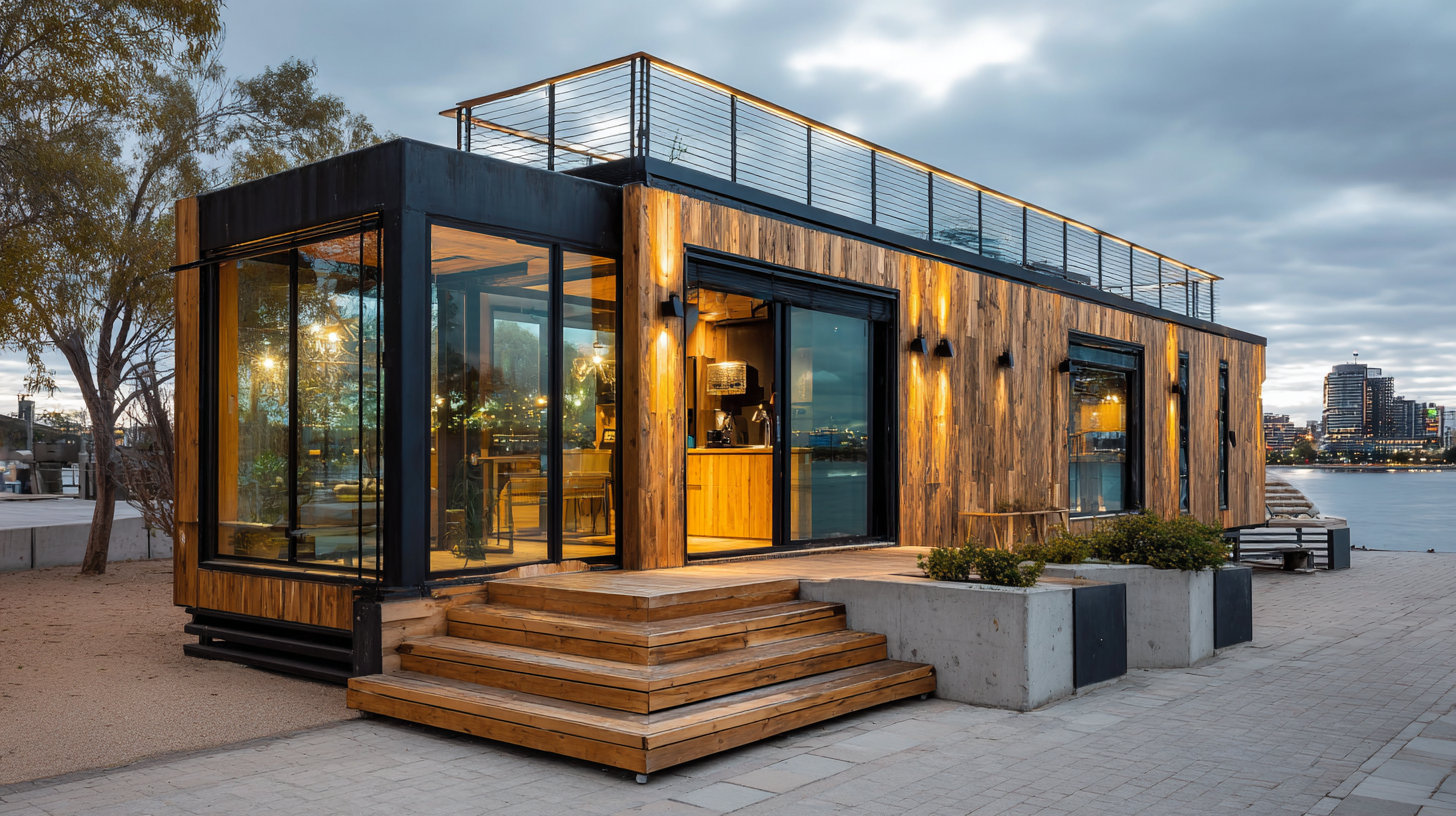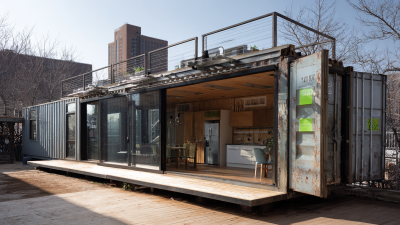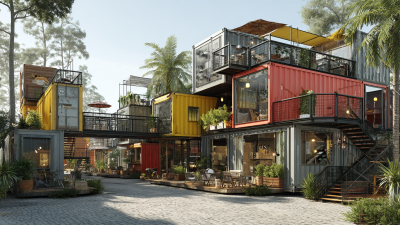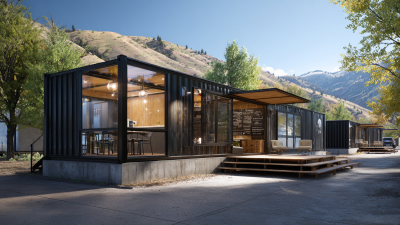Transforming Sustainability: The Rise of Innovative Cargo Container Houses in Modern Living
In recent years, the concept of sustainable living has gained significant traction, inspiring innovative approaches to housing that are both eco-friendly and cost-effective. One of the most intriguing developments in this realm is the rise of cargo container houses, which repurpose shipping containers into stylish, functional homes.
 These structures not only minimize waste by utilizing materials that would otherwise remain idle, but they also offer flexible and adaptable living spaces that cater to the needs of modern lifestyles. In this guide, we will explore the transformative potential of cargo container houses, highlighting their benefits, design possibilities, and the steps required to create your own sustainable sanctuary. By embracing this trend, individuals can contribute to a more sustainable future while enjoying the many advantages that come with innovative, container-based living.
These structures not only minimize waste by utilizing materials that would otherwise remain idle, but they also offer flexible and adaptable living spaces that cater to the needs of modern lifestyles. In this guide, we will explore the transformative potential of cargo container houses, highlighting their benefits, design possibilities, and the steps required to create your own sustainable sanctuary. By embracing this trend, individuals can contribute to a more sustainable future while enjoying the many advantages that come with innovative, container-based living.
Innovative Design Principles in Cargo Container Homes
Innovative design principles are at the forefront of transforming cargo container homes into sustainable living solutions. The versatility of cargo containers allows architects and designers to reimagine living spaces, utilizing modular structures that can be adapted to various environments. Each container can be configured to include smart layouts, maximizing natural light and airflow. This not only enhances the aesthetic appeal but also significantly reduces energy consumption, aligning with modern sustainability goals.
Additionally, the use of repurposed materials and green technologies in cargo container homes serves to minimize environmental impact. Integrating solar panels, rainwater harvesting systems, and green roofs, these innovative designs provide eco-friendly alternatives to traditional housing. The result is a harmonious blend of functionality and environmental consciousness, where each home tells a story of resourcefulness and modern living ethos. By prioritizing sustainable practices, cargo container houses reflect a shift towards a more resilient and adaptive lifestyle, encouraging a connection with nature and community.
Sustainable Living: Benefits of Cargo Container Structures
 As urban areas grapple with housing shortages and environmental concerns, cargo container structures are emerging as a sustainable alternative that offers numerous benefits for modern living. According to a report from the United Nations, over 1.6 billion people are expected to inhabit urban areas by 2030, highlighting the urgent need for innovative solutions in housing. Cargo container homes provide a unique opportunity to repurpose shipping materials, effectively reducing waste and minimizing the carbon footprint associated with traditional construction methods. In fact, the use of repurposed shipping containers can lead to a 50% reduction in construction waste compared to conventional building practices.
As urban areas grapple with housing shortages and environmental concerns, cargo container structures are emerging as a sustainable alternative that offers numerous benefits for modern living. According to a report from the United Nations, over 1.6 billion people are expected to inhabit urban areas by 2030, highlighting the urgent need for innovative solutions in housing. Cargo container homes provide a unique opportunity to repurpose shipping materials, effectively reducing waste and minimizing the carbon footprint associated with traditional construction methods. In fact, the use of repurposed shipping containers can lead to a 50% reduction in construction waste compared to conventional building practices.
Moreover, the design flexibility of cargo container homes allows for energy-efficient living spaces tailored to individual needs. A study from the International Energy Agency indicates that sustainable buildings can reduce energy consumption by up to 80% compared to standard structures. With features such as integrated solar panels and sustainable insulation materials, cargo container houses not only enable homeowners to significantly lower their utility costs but also contribute to a decrease in greenhouse gas emissions. As cities continue to evolve, cargo container homes stand out as a viable, sustainable solution that aligns with the growing demand for eco-friendly living options.
Challenges and Solutions in Cargo Container House Construction
The construction of cargo container houses has gained popularity as a sustainable living option, but several challenges must be addressed to ensure their viability. One of the primary issues is the structural integrity of repurposed containers. Often, these containers have been subject to harsh environmental conditions, leading to rust and deterioration. Prior to construction, thorough inspection and treatment of the containers are essential to mitigate these problems. Additionally, reinforcing the structure may be necessary to meet local building codes and provide adequate safety for occupants.
Another significant hurdle is insulation and energy efficiency. Cargo containers are typically made of metal, which can lead to extreme temperature fluctuations inside. To combat this, innovative insulation techniques must be implemented, such as incorporating advanced thermal materials within the walls or utilizing exterior cladding. Moreover, integrating renewable energy solutions, like solar panels, can enhance self-sufficiency and reduce reliance on traditional power sources. By overcoming these challenges through creative engineering and design, cargo container houses can become a practical and sustainable option for modern living.

The Role of Cargo Container Homes in Urban Development
The trend of using cargo containers as homes is significantly reshaping urban development, providing innovative solutions to pressing housing shortages. According to a report from the McKinsey Global Institute, urban populations are expected to grow by 2.5 billion by 2050, exacerbating the demand for affordable housing options. Cargo container homes offer a sustainable alternative, repurposing materials that would otherwise contribute to waste in landfills. Each container can be repurposed and transformed into a liveable space, serving as a striking example of innovation in construction.
Additionally, container homes can be constructed in a fraction of the time compared to traditional building methods, with timelines often reduced by nearly 50%, as noted in research by the National Institute of Building Sciences. This rapid assembly can accelerate the provision of housing in urban areas, particularly in response to disaster relief scenarios where swift action is essential. As cities search for cost-effective and environmentally friendly housing solutions, cargo container homes stand out, integrating seamlessly into the urban landscape while promoting sustainability and adaptability in modern living.
Future Trends in Container-Based Sustainable Housing Solutions
The trend of container-based sustainable housing solutions is rapidly gaining traction as urban areas grapple with housing shortages and environmental concerns. According to a report by McKinsey & Company, the demand for affordable housing is set to rise by 30% over the next decade, leading to innovative solutions such as cargo container homes. These structures not only utilize recycled materials, reducing waste, but also provide cost-effective alternatives for building modern living spaces. The Global Construction Outlook predicts that the market for sustainable building materials will grow by 15% annually, underscoring the shift towards eco-friendly housing options.
Tips: If you're considering container homes, evaluate your local zoning regulations to ensure compliance. Additionally, focus on insulation techniques to enhance energy efficiency, which can lead to significant savings on utility bills.
Future trends indicate an increasing integration of smart home technology in cargo container houses, allowing for enhanced energy management and improved living experiences. The use of renewable energy sources, such as solar panels, in these homes is on the rise, aligning with the trend identified in the International Energy Agency's report, which shows a 10% annual increase in solar energy installations within residential spaces. Container houses exemplify how innovation can be fused with sustainability, paving the way for a more environmentally-conscious approach to modern living.
Tips: Incorporate greenery around your container home to improve air quality and create a calming environment. Consider using rainwater harvesting systems to further enhance sustainability.
Growth of Innovative Cargo Container Houses (2018-2023)
This chart illustrates the growth trend of innovative cargo container houses as sustainable housing solutions from 2018 to 2023. The data shows an increasing interest in container-based housing, reflecting a shift towards more sustainable living practices.
Related Posts
-

Transforming Urban Living: Innovative Container Solutions for Modern Spaces
-

The Rise of Sustainable Living Through Shipping Container Flats
-

Transforming Shipping Containers into Sustainable Living Spaces: A 2023 Housing Solution
-

Transforming Everyday Life with Innovative Containers for Living Space
-

Transforming Tiny Spaces: How Containers Revolutionize Modern Living
-

Exploring the Future of Modular Container Buildings: Sustainable Solutions for Modern Living


